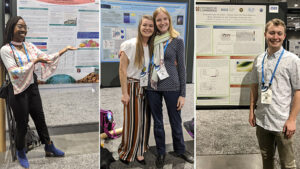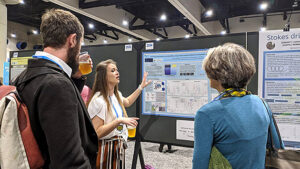BIOS Scientists Gather for Ocean Sciences Meeting

The biennial Ocean Sciences meeting in California this February drew participants from 60 countries and brought together representatives from BIOS including Moronke Harris (left), Jordan Wingate and Amy Maas (center), and James Hilditch.
Researchers and students representing BIOS gathered in San Diego, California, in mid-February to participate in the biennial Ocean Sciences meeting. The flagship conference, held jointly by the Oceanography Society, the American Society of Limnology and Oceanography, and the American Geophysical Union, attracted nearly 5,000 scientists, managers, and educators from around the globe.
The research of BIOS scientists spanned topics covering chemical, physical, and biological oceanography in geographic regions as diverse as the Sargasso Sea, the Pacific, and the North Atlantic. Participants included the following researchers and students presenting on behalf of BIOS:
Marine chemist Nicholas Bates, co-Principal Investigator for the Bermuda Atlantic Time-series Study (BATS) and Hydrostation ‘S’ projects to collect long-term, monthly data about biological, chemical, and physical ocean properties, was listed as co-author on seven research papers presented by colleagues attending the conference.

BIOS Research Experiences for Undergraduates (REU) intern Jordan Wingate explained the use of image tracking software to characterize the swimming kinematics of pteropods, or “sea butterflies.”
Zooplankton ecologist Leocadio Blanco-Bercial presented on his plankton research at the BATS site in the Sargasso Sea related to his work with the multi-year BIOS-SCOPE project (for Bermuda Institute of Ocean Sciences Simons Collaboration on Ocean Processes and Ecology). He was also listed on two additional presentations relating to other ongoing projects with colleagues at BIOS.
Organic geochemist Maureen Conte, along with Oceanic Flux Program (OFP) research scientist Rut Pedrosa Pamies, senior research assistant JC Weber, and several student interns working with the OFP time-series, presented a talk on carbon re-mineralization in the water column, and a poster on the role that hurricanes play to rapidly transport fresh organic material to the deep sea.
Chemical oceanographer Damian Grundle, along with students Brett Jameson and Annaliese Meyer, displayed posters and gave oral presentations related to their work in ocean observation, biology, and biochemistry. Grundle also co-chaired a special session related to ocean time-series studies.
Moronke Harris, a former Canadian Associates of BIOS (CABIOS) intern, presented a poster detailing her 2018 internship project on coral bleaching threats and solutions with BIOS coral reef ecologist Yvonne Sawall.
In collaboration with BATS co-Principal Investigator Rod Johnson, BATS technician Emily Davey (who specializes in nutrient analysis) presented a poster on their ongoing study of nutrients in spring plankton blooms observed at BATS. Another technician, Claire Medley, compared the results of two sampling techniques for studying phytoplankton pigments for her poster presentation. James Hilditch, a Cawthorn Cambridge Intern at BIOS, presented a poster coauthored by Maureen Conte, Rut Pedrosa Pamies, and former BATS technician Fernando Pacheco that used current data from the OFP mooring to describe the physical interactions between hurricanes and eddies. Johnson was also the lead author on a poster featuring his study, over two decades, of heat and salinity budgets of the Sargasso Sea.

Emily Davey (left) and Claire Medley presented research posters at the conference.
Zooplankton ecologist Amy Maas presented results from two ongoing projects: the National Science Foundation-funded circadian rhythm project and the BIOS-SCOPE program. She was also listed as a co-author on five presentations from her copepod work at BIOS. Among those was a poster presentation by 2019 BIOS Research Experiences for Undergraduates (REU) intern Jordan Wingate on the use of image tracking software to characterize the swimming kinematics of pteropods, or “sea butterflies.”
Microbial oceanographer Rachel Parsons presented a poster with colleagues at BIOS, the University of California Santa Barbara, and the University of Exeter in the United Kingdom looking at how surface microbes quickly degrade the carbon that accumulates within oxygen minimum zones, with a focus on Devil’s Hole in Bermuda.
Andrew Peters, environmental chemist and BIOS director of University Programs, and research technician Matthew Hayden, co-authored a poster with various other collaborators on atmospheric gas research, conducted at the Tudor Hill Marine Atmospheric Observatory in Bermuda.
Megan Sullivan, a graduate student at the University of California, Irvine, presented a poster detailing her 2019 internship project — applying glider observations to estimate the strength of the biological carbon pump — in collaboration with BIOS physical oceanographer Ruth Curry, who manages the Institute’s glider program.
